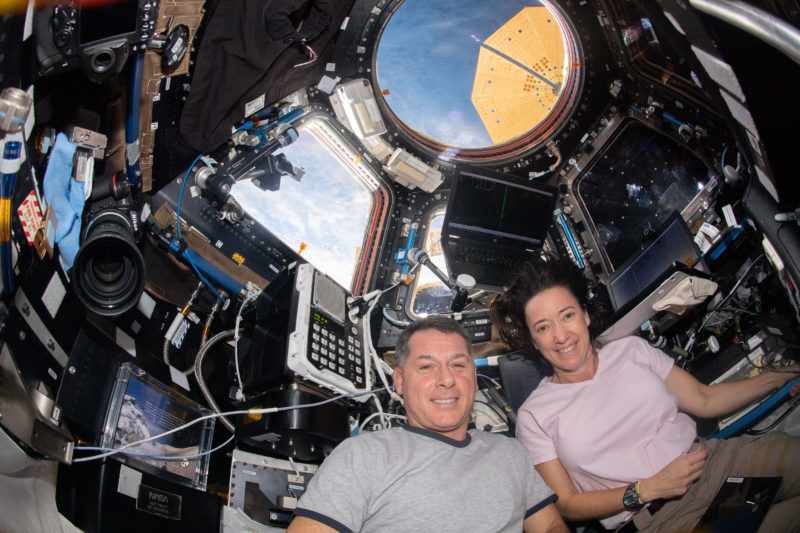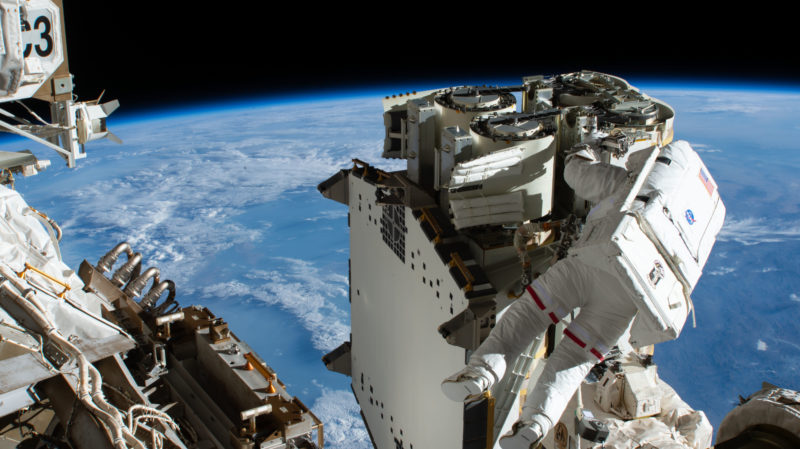
After more than a month in space, the CRS-22 Dragon—the second of at least six SpaceX cargo missions under the second-round Commercial Resupply Services (CRS2) contract with NASA—is homeward bound, laden with 5,300 pounds (2,400 kg) of cargo and experiment results. Launched atop a Falcon 9 booster from historic Pad 39A at the Kennedy Space Center (KSC) on 3 June, the cargo ship’s departure was originally targeted for Tuesday, but was postponed twice in response to extreme forecasted weather off the Florida Coast.
Citing the need for wind speeds and wave heights to be within mandated limits “to ensure the safety of the recovery teams, the science and the spacecraft”, NASA initially aimed to undock Dragon on Wednesday, before moving to Thursday. Following today’s smooth 10:45 a.m. EDT undocking, the cargo ship is due to splash down in the Gulf of Mexico, off the coast of Tallahassee, Fla., about 11:29 p.m. EDT Friday, to be recovered by the SpaceX vessel GO Navigator.

For the station’s incumbent Expedition 65 crew—Commander Aki Hoshide of Japan, his U.S. crewmates Mark Vande Hei, Shane Kimbrough and Megan McArthur, Frenchman Thomas Pesquet and Russian cosmonauts Oleg Novitsky and Pyotr Dubrov—the arrival and presence of CRS-22 brought with it a hive of activity and drama.
In the days before Dragon’s launch, the crew busied themselves for its rendezvous via computerized On-Board Training (OBT). Although Dragon’s approach and docking at the space-facing (or “zenith”) port of the Harmony node was entirely automated, Kimbrough and McArthur adopted a monitoring role throughout, ready to step in if necessary.

Unlike the 20 Dragons which voyaged to the ISS under the first-round CRS1 contract between May 2012 and March of last year, their upgraded CRS2 successors do not need to be robotically grappled, berthed and unberthed with the station’s 57.7-foot-long (17.6-meter) Canadarm2. Starting with last December’s flight of CRS-21 and continuing on CRS-22, they instead approach the station and dock autonomously. A side benefit is that this practice reduces the impact on crew time.
“Duties for the crew on approach are significantly different with this version of Dragon,” NASA previously told AmericaSpace. “Crew has no active tasks like they did for capture and are strictly monitoring. They still have full capability to send commands to vehicle for things like abort, but if all goes well they don’t have to send any commands or take any actions for Dragon to dock.”

With around 7,340 pounds (3,880 kg) of payloads and supplies heading uphill on CRS-22, the Expedition 65 crew correspondingly began preparing for a month-long science marathon in advance. They began reviewing procedures for one experiment on 3 June, the very day that Dragon launched.
Known as Targeting Improved Cotton Through On-Orbit Cultivation (TICTOC), it uses cotton to assess how roots affect the resilience of plants to stress, water-use efficiency and carbon sequestration during seedling establishment. Such research forms part of a wider aim of growing plants for future missions into deep space.

Following Dragon’s arrival on 5 June, the cargo ship was quickly accessed and the lengthy process of unloading its contents began. On the 7th, the crew removed the Advanced Space Experiment Processor (ADSEP)-2 from Dragon and installed it into an Expedite the PRocessing of Experiments for Space Station (EXPRESS) rack to begin the first runs of an experiment looking at newly-hatched bobtail squid. Understanding of Microgravity on Animal-Microbe Interactions (UMAMI) seeks to determine how microbes colonize and influence animal development processes, with applications including better protective measures for astronauts on long-duration deep-space missions.
Also that day, they transferred the Kidney Cells-02 hardware out of Dragon and into the controlled environs of the Space Automated Bioproduct Laboratory (SABL), as well as setting up the TICTOC hardware and photographing its 12 plant-growth chambers.

This allowed ground-based investigators to evaluate the status of TICTOC’s growing cotton plants. Several days later, on 11 June, Kimbrough harvested the TICTOC samples, with some specimens being “fixed” and others “frozen”, ahead of their return to Earth, in order to preserve them for post-flight analysis.
The CRS-22 research had well and truly hit its stride by the second week of June, when the first Kidney Cells-02 media exchanges were performed inside the Life Science Glovebox (LSG), situated in Japan’s Kibo lab. Launched in September 2018, the 15-cubic-foot (0.4-cubic-meter) LSG affords researchers the benefits of adjustable lighting, air filtration, video recording and real-time downlink.

This particular experiment used a three-dimensional kidney cell “chip” to study the effects of microgravity on the formation of microcrystals in kidney tubules, as part of efforts to develop better treatments for kidney stones and osteoporosis. Samples were “fixed” and kept in the Minus-Eighty-Degree Laboratory Freezer for ISS (MELFI) for preservation on 11 June.
Elsewhere, the Bioculture system was removed from Dragon and installed into an EXPRESS rack, ahead of the Cell Science-04 experiment in mid-July. This investigation centers upon a peculiar microscopic extremophile called the “tardigrade” (or “water-bear”) to understand its biological survival mechanisms. Tardigrades are known to be capable of enduring multiple extreme environments and have survived, thrived and even reproduced in the harsh conditions of low-Earth orbit.

But alongside the science, CRS-22’s most visible payload was the first pair of Boeing-built ISS Roll-Out Solar Arrays (iROSAs), which will eventually outfit six of the station’s eight “legacy” Solar Array Wings (SAWs) with improved power-producing potential. The iROSAs will overlay and “shadow” the existing arrays to increase the station’s electrical capabilities from 160 kilowatts to 215 kilowatts—a hike of 20-30 percent—in support of burgeoning ISS commercial and payload needs.
Flown uphill in Dragon’s unpressurized trunk, the first set of iROSAs—affixed to an Integrated Payload Assembly (IPA) and destined to overlay and shadow Power Channels 2B and 4B on the aging P-6 truss—were remotely extracted overnight on 10/11 June, with Canadarm2 under the deft command of the Robotics Officer (ROBO) in Mission Control. The iROSA unit was “temp-stowed” on a Payload and Orbital Replacement Unit Accommodation (POA) on the station’s truss, a process which was concluded successfully, despite a software issue with a POA camera.

There it remained to await a pair of spacewalks by Kimbrough and Pesquet to install the iROSAs, with the first targeted to tackle Power Channel 2B and the second aiming to upgrade Power Channel 4B. However, difficulties installing the new hardware and a couple of issues with Kimbrough’s space suit meant those two sessions of Extravehicular Activity (EVA) ultimately became three and the new iROSAs were fully installed, unfurled and activated by the evening of 25 June.
“The first iROSAs began drawing power immediately during the first orbital daylight, post-deployment, and are performing well,” NASA told AmericaSpace. “Ground teams will continue to collect data on performance and compare to last year’s information, calculating the total power gained.”

Even as Kimbrough and Pesquet’s nine-day EVA marathon was underway, efforts to unload and reload Dragon with cargo continued unabated. Finally, late on 29 June, the empty Flight Support Equipment (FSE) carrier for the iROSAs was stowed via Canadarm2 into Dragon’s trunk for disposal. And last Thursday, the Expedition 65 crew finished packing the lower part of the cargo ship’s three-story pressurized element—nicknamed “the basement”—with hardware that would head home.
Returning home among Dragon’s 5,300-pound (2,400 kg) haul were the TICTOC specimens, the Kidney Cells-02 samples and results from another experiment, called Lyophilization-02, which sought to evaluate improved freeze-drying processes for the pharmaceutical and other industries. This might also lead to new insights into extending the shelf-life of Earth-based medicines. At various points in June, both McArthur and Vande Hei worked with the Lyophilization-02 experiment, which was housed inside the Microgravity Science Glovebox (MSG) in the U.S. Destiny lab.

Monitoring Dragon’s undocking on Thursday morning was Kimbrough, reprising a similar role he took during the arrival of the cargo ship last month. Physical separation of the two space vehicles occurred at 10:45 a.m. EDT, as they flew 260 miles (420 km) over the South Atlantic Ocean. Shortly after undocking, the spacecraft executed a pair of thruster “burns” to depart the vicinity of the station and by 10:57 a.m. EDT had left the 650-foot (200-meter) “Keep-Out Sphere”. Splashdown is currently scheduled to occur in the Gulf of Mexico, off Tallahassee, about 11:29 p.m. EDT Friday.
In the meantime, a busy few weeks lie ahead for the station, with the second Orbital Flight Test (OFT-2) of Boeing’s CST-100 Starliner spacecraft due to launch atop a United Launch Alliance (ULA) Atlas V booster from Space Launch Complex (SLC)-41 at Cape Canaveral Space Force Station, Fla., at 2:53 p.m. EDT on 30 July.

This will kick off a planned four-to-five-day mission, which will see the Starliner demonstrate its ability to rendezvous, dock and undock from the ISS. In readiness for the flight, Kimbrough, McArthur, Hoshide and Pesquet will relocate their Crew Dragon Endeavour from the forward-facing port of Harmony to the zenith port, no earlier than 21 July. This will open up the forward port for Starliner.
Hardware is also coming together for the next U.S. cargo mission, Northrop Grumman’s NG-16 Cygnus, which will launch atop an Antares booster from Pad 0A at the Mid-Atlantic Regional Spaceport (MARS) on Wallops Island, Va., no sooner than 5:55 p.m. EDT on 10 August.

Laden with an anticipated 8,000 pounds (3,600 kg) of equipment, payloads and supplies—including the second iROSA modification kit, to be installed by spacewalkers in late August—Cygnus will remain attached to the station until the fall. “We expect a very full Cygnus spacecraft to accommodate increased human travel to the International Space Station,” Northrop Grumman recently told AmericaSpace.
The Pressurized Cargo Module (PCM) arrived at Wallops in May and was mated to the Service Module (SM) late last month, with fueling concluded in early July. Around the middle of this month, the complete spacecraft will be transferred to the Horizontal Integration Facility (HIF) for initial cargo loading. Key payloads include an experiment to demonstrate 3D printing in space with a lunar-soil simulant material, a student-led investigation into slime-mold behavior and new carbon dioxide removal technologies.






6 Comments
6 Pings & Trackbacks
Pingback:Atlas V, Starliner Set for Historic Space Station Launch on Friday
Pingback:Atlas V, Starliner Set for Historic Space Station Launch on Friday « AmericaSpace
Pingback:Starliner Valve Issue Delays OFT-2, Next Launch Attempt TBD
Pingback:Crew-2 Returns Home, Wraps Up Longest Single Mission by U.S. Crewed Spacecraft – AmericaSpace
Pingback:CRS-24 Dragon Launches, Heads to Space Station – AmericaSpace
Pingback:CRS-24 Dragon Launches, Heads to Space Station - d-International News